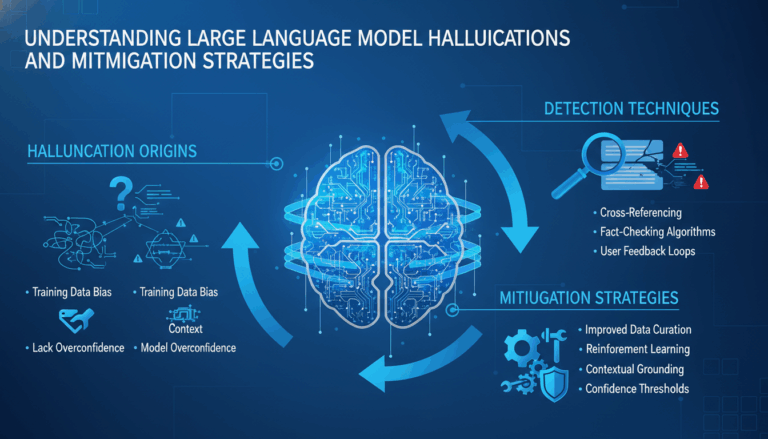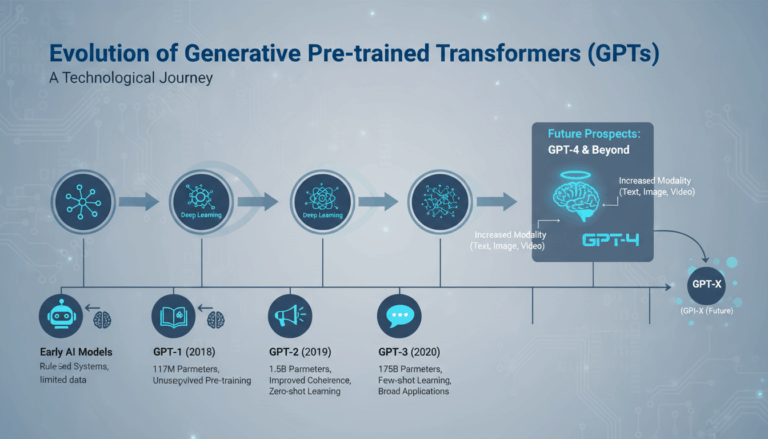Introduction to LangGraph and Graph-Based Reasoning
LangGraph represents an innovative approach in transforming conversational AI through the utilization of graph-based reasoning. At its core, LangGraph leverages the powerful capabilities of graph theory to model and enhance the interactions within chatbot systems. By understanding the complex relationships between different components of conversation, LangGraph allows for more nuanced and contextual interactions.
Graphs, consisting of nodes and edges, have been extensively used to represent various structured data types. In the context of LangGraph, nodes typically signify linguistic elements such as words, phrases, or entire sentences, while edges denote the relationships or transitions between these elements. This graphical representation facilitates a more intuitive understanding of conversation flow and enables the chatbot to perform sophisticated reasoning tasks that go beyond linear text processing.
One of the primary benefits of utilizing graph-based reasoning is its ability to capture and analyze complex relationships. For example, in a customer service chatbot, understanding whether two separate conversations are related by context or topic can significantly enhance the support experience. If a customer inquires about shipping details in one instance and tracks a package in another, LangGraph can identify these interactions as contextually linked, ensuring a seamless user experience.
Moreover, graph-based reasoning supports the implementation of advanced features such as sentiment analysis and intent detection. By modeling potential paths of conversation as graphs, LangGraph can highlight key turning points or emotional shifts within dialogues. This heightened awareness allows chatbots to react more empathetically and appropriately, tailoring responses to user needs dynamically.
Another powerful application of LangGraph is in personalization and recommendation systems. By mapping user interactions as graphs, chatbots can predict and anticipate user needs more accurately. For instance, if a user frequently asks about a particular product category, the system can proactively offer updates or promotions related to that interest, enhancing user engagement and satisfaction.
Furthermore, incorporating graph databases enhances scalability and performance efficiency. Graph databases, such as Neo4j or TigerGraph, provide optimized methods for storing and querying complex relationships inherent in graph structures. These technologies ensure that as chatbots scale to accommodate growing user bases and interaction complexity, their performance remains robust.
In practice, implementing a system like LangGraph involves a few crucial steps. Initially, developers must define the ontology or schema that outlines the nodes and relationships relevant to their specific application. Following this, appropriate graph structures are chosen and implemented, leveraging available graph library tools or frameworks. Continuous monitoring and refinement of these structures are essential to adapting to evolving conversational needs and maintaining the effectiveness of graph-based reasoning.
LangGraph’s graph-based reasoning empowers chatbots to deliver richer, contextually aware interactions that significantly enhance the user experience. By bridging the gap between human-like understanding and machine efficiency, LangGraph stands at the forefront of next-generation conversational AI development.
Setting Up the Development Environment
Establishing the development environment for working with LangGraph involves several critical steps that ensure a smooth setup process and facilitate efficient development. These steps include selecting the right tools, configuring necessary software, and preparing the workspace to accommodate graph-based applications.
Begin by selecting an appropriate programming language. Python is a popular choice for AI and machine learning development due to its extensive library support and community resources. Libraries such as NetworkX for network analysis and graph handling, or PyTorch and TensorFlow for AI functionalities, are widely utilized. However, depending on your specific needs, consider other languages like JavaScript or Java if your deployment environment demands it.
Next, set up a Python virtual environment to manage dependencies neatly and avoid conflicts. This can be set up using venv or conda. With venv, use the following commands to create and activate a virtual environment:
python3 -m venv langgraph_env
source langgraph_env/bin/activate # On Windows, use `langgraph_env\Scripts\activate`
Once the environment is activated, proceed by installing essential libraries and tools. Use either Pip or Conda to install the required packages. For graph-specific processing, consider installing NetworkX:
pip install networkx
If your project includes machine learning aspects, you might install PyTorch or TensorFlow as follows:
pip install torch # For PyTorch
pip install tensorflow # Alternatively, for TensorFlow
Additionally, choosing a graph database is crucial when implementing LangGraph. Neo4j is highly recommended due to its robust support for complex queries, scalability, and user-friendly interface. Begin by downloading and installing Neo4j from its official site (neo4j.com). Once installed, start the Neo4j server with:
neo4j start
Access the Neo4j browser at http://localhost:7474 in a web browser to interact with the database.
Set up a code editor that supports your development needs effectively. Visual Studio Code is a versatile choice, offering extensions for Python, database query support, and integrated terminal, making it a comprehensive IDE option.
For version control, integrate Git into your workflow if it’s not already. Initiate a local Git repository within your project directory:
git init
Connect this to a remote repository on GitHub, GitLab, or another provider, enabling collaborative version control and backup for your work.
Ultimately, configure any necessary environment variables. If you are using a database like Neo4j, ensure you store sensitive configurations, such as database credentials, securely – possibly through environment variables or a configuration file excluded from version control.
Finally, validate your environment by running a simple test script that initializes a basic graph structure and performs a straightforward query. This step assures that all components are operational and properly configured, enabling you to proceed with developing more complex LangGraph applications confidently.
Being thorough in setting up your development environment is critical for streamlining the development process and ensuring efficient progression through further stages of building and refining LangGraph-based conversational AI systems.
Building a Basic Chatbot with LangGraph
Crafting a chatbot with LangGraph involves leveraging the capabilities of graph-based reasoning to create a system that is contextually aware and capable of more nuanced interactions. Here is a step-by-step guide to building a basic chatbot using LangGraph:
Define the Chatbot’s Objectives
Before diving into the technical aspects, clearly define what your chatbot is supposed to accomplish. Whether it’s customer support, personalized recommendations, or general information delivery, understanding the scope helps in structuring the conversational flow effectively.
Set Up the Core Libraries and Dependencies
If you haven’t already set up your development environment, make sure to initialize a Python environment using tools like venv for managing dependencies. Start by installing NetworkX for managing graph structures:
pip install networkx
If you intend to integrate machine learning functionalities, you can also include packages like PyTorch or TensorFlow:
pip install torch
# or
tensorflow
Modeling Conversations with Graphs
Modeling your conversations involves identifying key components — such as user intents, responses, and transitional dialogue elements — that will form the nodes of your graph. Begin by sketching a conversational roadmap. For example, nodes can represent intents like asking a price, requesting support, or confirming details, while edges will define the transitions based on user inputs.
Implement this structure in code using NetworkX:
import networkx as nx
g = nx.DiGraph() # Use a directed graph for directed conversations.
# Add nodes for conversational intents.
g.add_node('greeting')
g.add_node('product_inquiry')
g.add_node('farewell')
# Define edges to represent dialogue transitions.
g.add_edges_from([
('greeting', 'product_inquiry'),
('product_inquiry', 'farewell'),
('greeting', 'farewell')
])
You can extend this setup extensively by adding more nodes and complex transitions as your chatbot scales.
Integrate with a Graph Database
To handle more complex queries and relationships, integrating LangGraph with a graph database like Neo4j is crucial. Install Neo4j, start a local instance, and use its query capabilities to manage conversation data:
neo4j start
Incorporate Neo4j in your chatbot setup with Py2neo, a popular Neo4j binding for Python:
pip install py2neo
Use the following to connect to your Neo4j database:
from py2neo import Graph
graph = Graph("bolt://localhost:7687", auth=("neo4j", "your_password"))
Implement the Chatbot’s Logic
Having built your graph and database, the next step is creating the logic that handles incoming messages. A basic implementation could be a function that receives user input, determines the current node (intent), and selects the next node based on edges from the current node.
def handle_message(input_message):
# Simple intent recognition (could be improved with ML models)
if 'price' in input_message:
current_intent = 'product_inquiry'
elif 'bye' in input_message:
current_intent = 'farewell'
else:
current_intent = 'greeting'
# Navigate to the next response based on the graph structure
if current_intent in g:
possible_transitions = list(g.successors(current_intent))
if possible_transitions:
next_intent = possible_transitions[0] # Simplified decision-making
return next_intent # Output this as the chatbot's response
# Fall back if no transition is found
return "I'm not sure about that. Can you please elaborate?"
Testing and Refinement
After implementing the basic functionality, engage in thorough testing. Simulate various conversations to ensure that the transitions work smoothly and intent recognition is accurate. Utilize logs and user feedback to refine the chat flows and improve the underlying logic.
Continuous iteration is key to enhancing your LangGraph chatbot. As you gain insights from real user interactions, iterate on the graph model, gradually increasing its complexity to handle more diverse conversational patterns. Incorporating machine learning models for intent classification can further enhance the system’s ability to understand user queries more accurately, making your chatbot smarter and more user-friendly.
By following these steps, you can build a foundational chatbot using LangGraph, equipped with the potential for advanced conversational AI development.
Implementing Graph-Based Reasoning in Chatbots
To implement graph-based reasoning in chatbots, begin by understanding how this approach enhances conversational capabilities. Graph-based reasoning allows the modeling of dialogue as graphs, where nodes represent conversational elements such as intents or entities, and edges define the relationships or transitions between these nodes. This model supports more sophisticated interaction flows compared to linear dialogue processing, enabling nuanced understanding and contextual awareness.
Start by defining your chatbot’s purpose. Whether the goal is customer service or information retrieval, having a clear understanding of its objectives will guide the structure of your graph and the reasoning processes involved. Ensure your graph model reflects the complexity of user interactions, capturing various conversational paths and providing a rich basis for reasoning.
Constructing the Graph
- Define Nodes and Edges: Begin by identifying key conversational elements that will form the graph’s nodes. These could be intents such as greeting, product inquiry, or complaint resolution. Each node represents a unique conversational stance or task. Edges between nodes depict possible transitions triggered by user inputs or external data signals.
For instance:
“`python
import networkx as nx
conversation_graph = nx.DiGraph()
# Adding nodes
conversation_graph.add_nodes_from([‘greeting’, ‘product_query’, ‘farewell’, ‘complaint’])
# Adding edges to represent transitions
conversation_graph.add_edges_from([(‘greeting’, ‘product_query’), (‘product_query’, ‘farewell’), (‘product_query’, ‘complaint’), (‘complaint’, ‘farewell’)])
“`
- Incorporate Contextual Information: Enhance nodes with attributes that provide context. This could involve storing user history or previous interactions, enabling the chatbot to choose responses based on historical data.
Reasoning Mechanism
- Contextual Pathways: Implement pathways that dictate how different inputs traverse the graph. Employ graph traversal algorithms to determine the path from the current state to the desired conversational outcome, ensuring the chatbot’s responses are contextually aware.
“`python
def update_conversation(intent):
if intent in conversation_graph:
next_possible_intents = list(conversation_graph.successors(intent))
# Apply logic to choose next intent based on additional context or probability
selected_intent = next_possible_intents[0] # Simplified choice for illustration
return selected_intent
return None
“`
- Data-Enriched Decisions: Utilize external data through APIs to inform graph transitions. This enhances the chatbot’s adaptability, allowing it to react dynamically based on real-time data. For example, if the chatbot identifies an inquiry about a product, it might query a product database to provide enriched information directly from the source.
Leveraging a Graph Database
- Deploy a Graph Database: Integrate a graph database such as Neo4j to manage large volumes of conversational data efficiently. This integration allows complex querying and high scalability, crucial when expanding chatbot functionalities to cover more extensive and detailed user interactions.
“`python
from py2neo import Graph
graph_db = Graph(“bolt://localhost:7687”, auth=(“your_username”, “your_password”))
# Example of creating a node in Neo4j
graph_db.run(“CREATE (n:Intent {name:’greeting’})”)
“`
- Querying the Graph Database: Use Cypher queries to extract information from the database, making decisions based on stored interaction patterns or user data analysis.
cypher
MATCH (n:Intent {name: 'greeting'})-[:NEXT]->(m)
RETURN m.nameIntegrating Machine Learning
To augment graph-based reasoning, incorporate machine learning models tailored for intent detection and natural language understanding. Such models can preprocess user input to identify intents before engaging the graph logic, ensuring precise navigation through the conversational graph.
-
Model Setup: Train natural language processing models using frameworks like TensorFlow or PyTorch. These models detect intents with improved accuracy, feeding results into the graph to determine logical pathways.
-
Seamless Integration: Deploy these models alongside your graph logic to refine interactions continuously based on evolving user input patterns, enhancing the overall robustness and adaptability.
By implementing graph-based reasoning, chatbots achieve a higher level of sophistication in managing and understanding conversations. This approach empowers them to process complex dialogues, offering responsive, contextually enriched experiences that meet diverse user needs effectively. As your implementation matures, continuously refine your graph structures and reasoning strategies in response to real-world usage insights to maintain relevance and effectiveness.
Enhancing Chatbot Capabilities with Advanced Graph Structures
The use of advanced graph structures in chatbots is a transformative step in improving their conversational depth and efficiency. These structures enhance the chatbot’s ability to understand and process complex interactions by modeling dialogue as intricate graph networks. Here’s how you can extend your chatbot’s capabilities using advanced graph structures.
Graph structures like multi-relational graphs or hypergraphs allow for richer representation of conversational elements. In these structures, nodes can represent not just single entities like intents or concepts, but also complex structures such as entire dialogue contexts or user interaction histories.
Advanced Node and Edge Definition
1. Multi-dimensional Nodes: Instead of single-dimension nodes that only represent individual items (like an intent or a single user interaction), multi-dimensional nodes can encapsulate various attributes of a conversation. For example, a node could encompass an entire dialogue context including user mood, recent interactions, and inferred intents.
- Implementation Tip: Use attributes within nodes to store additional information. Consider the following Python snippet leveraging NetworkX:
“`python
import networkx as nx
graph = nx.DiGraph()
node_attributes = {
‘greeting’: {‘context’: ‘initial’, ‘mood’: ‘neutral’},
‘product_inquiry’: {‘context’: ‘shopping’, ‘mood’: ‘curious’}
}
graph.add_nodes_from(node_attributes.items())
“`
2. Hyperedges: Traditional graphs have single relationships between two nodes. Hyperedges allow multiple nodes to be connected with a single edge, capturing more complex interactions and dependencies useful in dialogue systems where multiple intents might interact simultaneously.
- Implementation Strategy: Integrate hypergraph libraries or implement custom logic to track these complex relationships. For a chatbot, this might involve tracking user interactions that lead to multiple branch paths being activated concurrently.
Leveraging Graph Pathways for Enhanced Responses
1. Intent Resolution Mechanisms: By utilizing advanced pathways between nodes, chatbots can traverse more complex dialog routes, providing responses that are contextually enriched and more aligned with what the user seeks.
- Example: Consider a user asking about product features after a general greeting; the graph can navigate through nodes like (‘greeting’, ‘product_info’, ‘features_detail’) seamlessly without losing contextuality.
2. Contextual Awareness: Advanced graphs can dynamically assess user context to adjust dialogue pathways. By evaluating the user’s interaction history captured in nodes and edges, chatbots can tailor their responses to fit the established context, enhancing interaction quality.
Integration with Machine Learning
Incorporating machine learning to advance graph-based chatbot systems involves using algorithms to continually refine the nodes and edges based on user interactions, ensuring the graph remains reliable and effective as a tool for dialogue processing.
-
Model Integration: Train models to predict which paths in the graph would yield the best user responses. Utilize ML algorithms to analyze historical data, determining the most effective conversation pathways.
-
Real-Time Updates: Implement continuous learning systems that adjust edge weights or node attributes in real-time, reflecting changes in user behavior or preferences, ensuring the chatbot remains responsive to trends.
Enhancing Personalization
Graph structures also enable enhanced personalization by tracking complex relationships and past interactions more effectively. Personalized experiences are created by analyzing user-specific paths through the conversation graph, and delivering relevant, customized responses based on mapped preferences and past behavior.
-
User-Centric Nodes: Maintain detailed user profiles within the graph nodes, facilitating targeted interactions. These can include interaction patterns, sentiment scores, and previously asked questions.
-
Recommendation Systems: Implement recommendation engines within the graph framework to suggest next best actions or products, drawing from external data sources and past user preferences.
Advanced graph structures provide a robust foundation for chatbots, driving them toward a future where they are not only responsive but also adaptively intelligent, anticipating user requirements and navigating conversational complexities seamlessly. By structuring nodes and pathways to reflect expansive possibilities, chatbots can achieve heightened understanding and relevance, making interactions more meaningful and effective for users.




